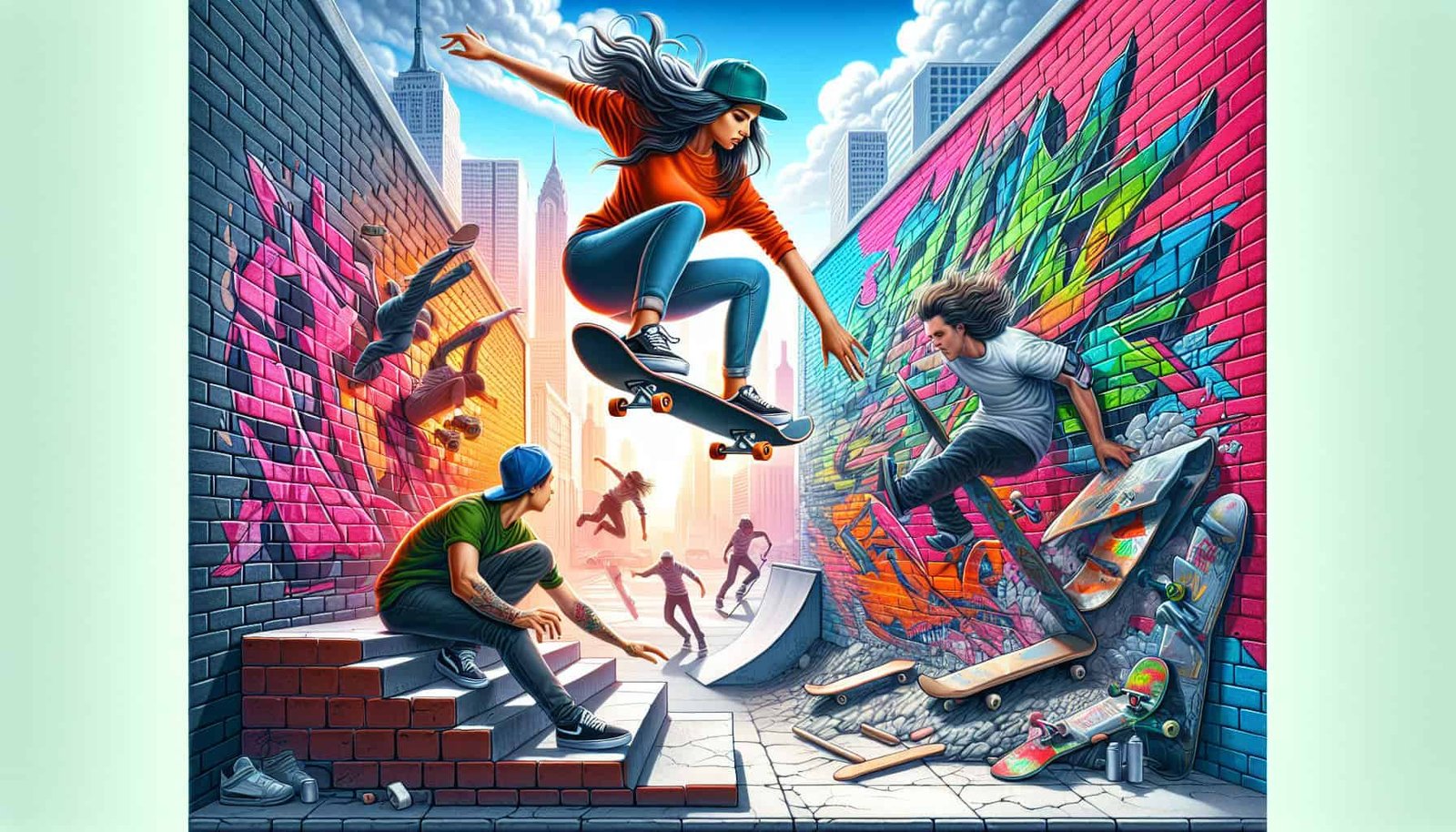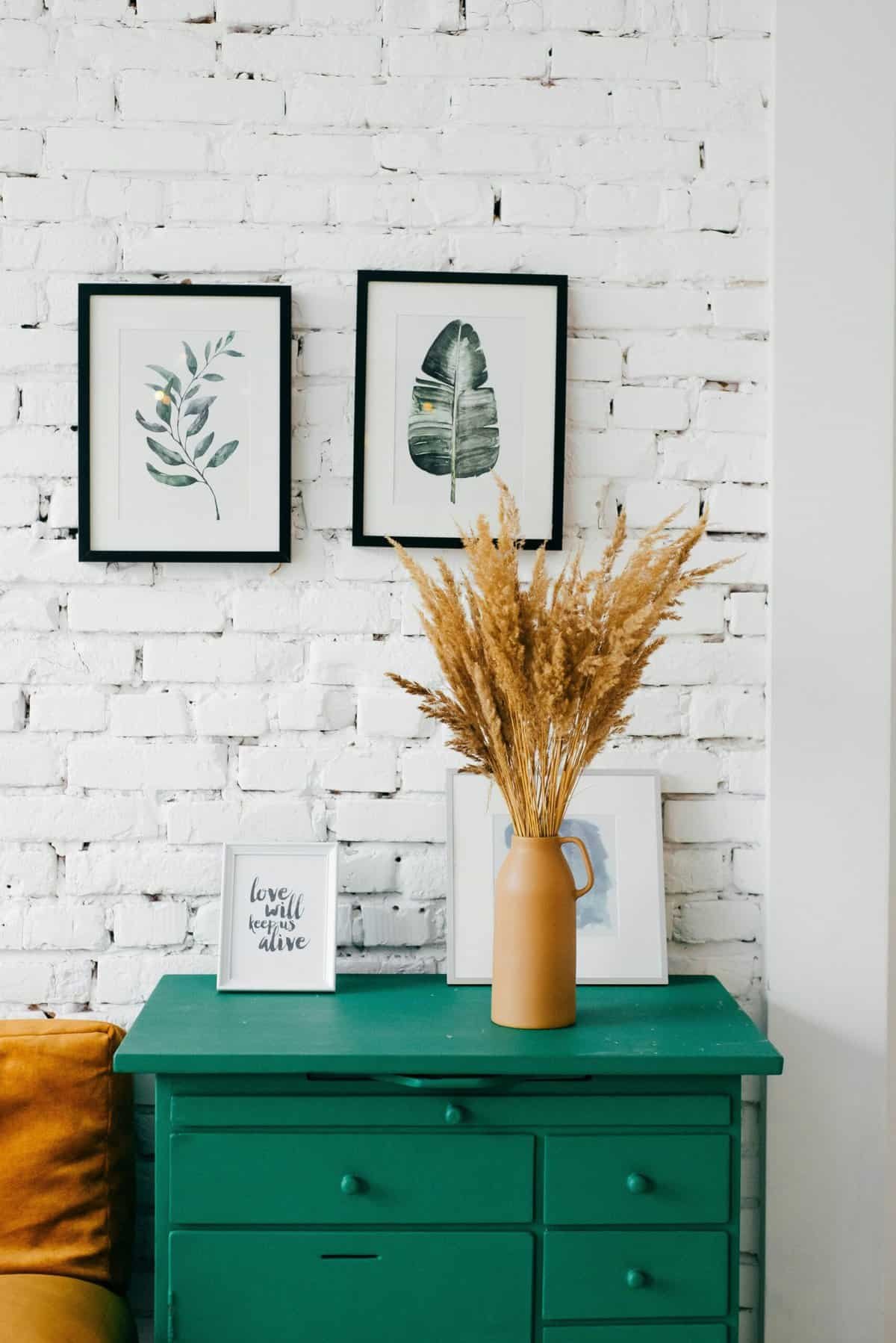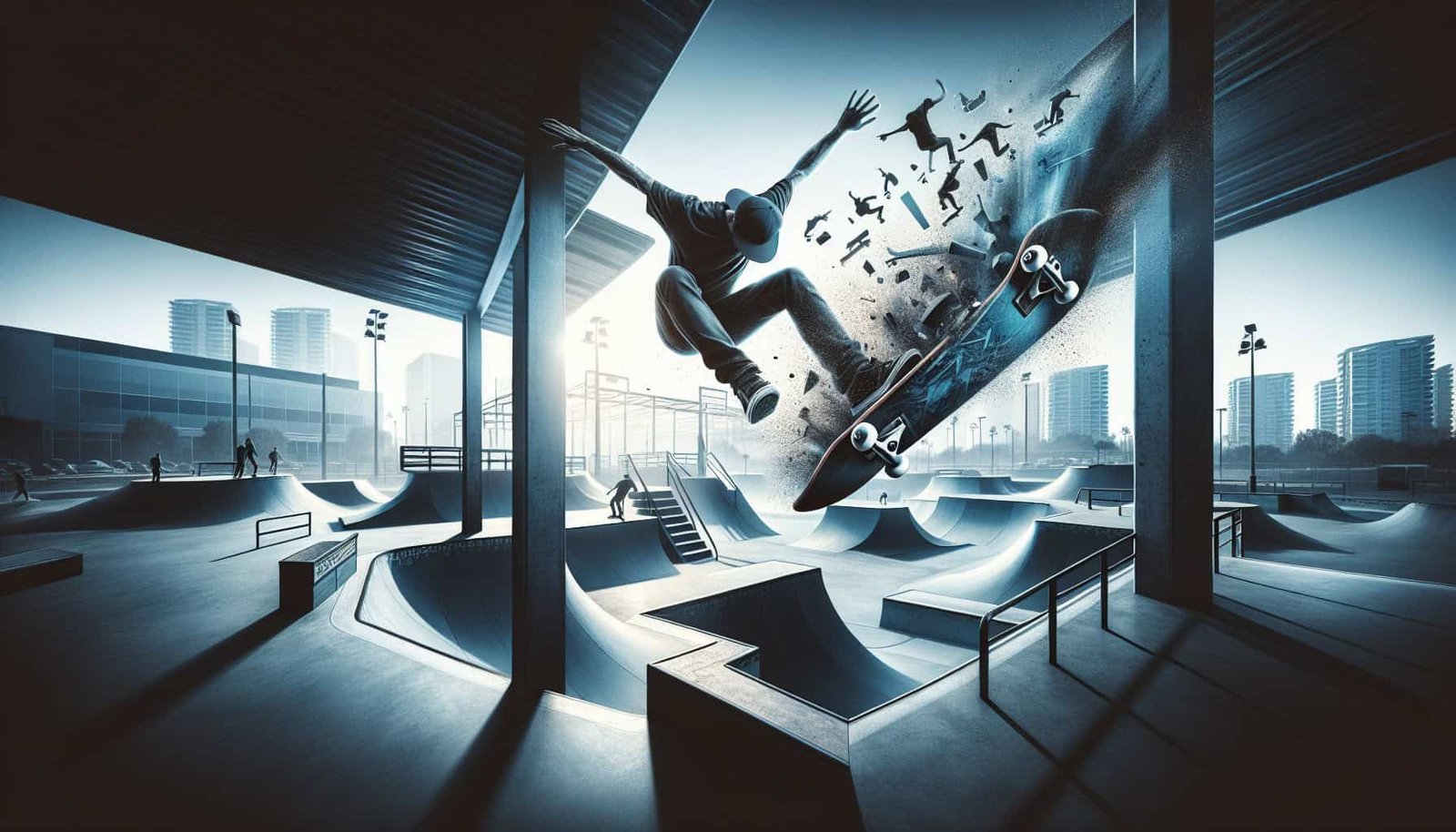If you’ve ever watched skateboarders effortlessly glide across walls and perform gravity-defying tricks, you may have found yourself wondering, “How do they do that?” Well, wonder no more. In this article, we’ll explore the key skills and strategies needed to master two popular skateboard tricks: wall rides and slappies. Whether you’re a beginner looking to up your skateboarding game or a seasoned pro seeking to refine your technique, we’ve got you covered. So grab your board, put on your helmet, and let’s get rolling!

Key Skills for Performing Skateboard Wall Rides
Skateboard setup and position
Having the right skateboard setup and position is essential for performing successful wall rides. Ensure that your skateboard is in good condition with properly tightened trucks, and suitable wheels for grip. Position yourself on the skateboard with your feet placed evenly and securely on the bolts, ready to execute the trick.
Balancing and weight distribution
Maintaining balance and proper weight distribution is crucial during a wall ride. Distribute your weight evenly on the board, keeping your shoulders aligned with the skateboard. Balancing your body correctly will help you stay in control and prevent any unnecessary falls.
Approach and speed control
Approaching the wall with the correct speed is important for executing a successful wall ride. Start by gradually increasing your speed as you approach the wall. It’s crucial to have good speed control to ensure a smooth transition onto the wall without losing balance or control.
Ollieing onto the wall
The ollie is a fundamental skateboarding trick that is required for wall rides. Practice your ollie technique to ensure a solid pop and timing, allowing you to launch yourself onto the wall. The ollie plays a significant role in gaining height and control during a wall ride.
Maintaining control on the wall
Once on the wall, it’s essential to maintain control and balance. Keep your knees slightly bent and your body centered over the skateboard. This will allow you to adjust and respond to any changes in the surface or obstacles on the wall, ensuring a smooth and controlled ride.
Body positioning and alignment
Proper body positioning and alignment are crucial for performing skateboard wall rides. Keep your body aligned with the direction of the wall and your skateboard. Maintain a low center of gravity, with your shoulders and hips facing forward. This will provide stability and control as you ride along the wall.
Carving and pumping
Carving and pumping are techniques used to generate speed and maintain momentum during a wall ride. Utilize subtle and controlled turns or carves to navigate the wall. By shifting your weight and pumping your legs, you can maintain speed and control while riding along the wall.
Powerful leg pushes
Powerful leg pushes are essential for gaining momentum and height during a wall ride. Utilize your back foot to generate a strong push against the ground, propelling yourself upward and onto the wall. The power and precision of your leg pushes play a crucial role in the success of the trick.
Upper body strength and stability
Having upper body strength and stability is beneficial for maintaining control and balance during a wall ride. Strengthen your arms, core, and back muscles through exercises such as push-ups, pull-ups, and planks. This will significantly improve your ability to stay stable and in control while riding along the wall.
Confidence and mental focus
Confidence and mental focus are key skills for performing successful skateboard wall rides. Trust in your abilities and believe in yourself to execute the trick. Maintain a clear and focused mindset, visualizing the trick before attempting it. Confidence and mental focus will contribute to a smoother and more controlled wall ride.
Strategies for Performing Skateboard Wall Rides
Choosing suitable wall ride spots
When performing skateboard wall rides, it’s crucial to choose suitable spots. Look for walls with a smooth surface and minimal obstacles or hazards that could interfere with the trick. Avoid walls that are too steep or rough, as they can make it challenging to maintain control and balance.
Analyzing the surface and obstacles
Before attempting a wall ride, analyze the surface and identify any potential obstacles or hazards. Ensure that the wall is free from loose gravel, debris, or cracks that could impede your ride. By assessing the surface and obstacles beforehand, you can plan your approach and ride more effectively.
Understanding the physics and angles
Understanding the physics and angles involved in wall rides is essential for optimal performance. Familiarize yourself with the concept of using the wall as a ramp, utilizing the angles to gain height and maintain control. Understanding how to manipulate your body and skateboard in relation to the wall will enhance your wall ride abilities.
Visualizing the trick and line
Visualization is a powerful tool for skateboarders. Before attempting a wall ride, visualize yourself successfully executing the trick. Visualize the line you want to follow on the wall, envisioning each step and movement required. This mental preparation will help you anticipate the trick’s execution and increase your chances of success.
Practicing on low obstacles
Start by practicing wall rides on low obstacles such as curbs or smaller walls. This allows you to develop the necessary skills and techniques needed to progress to higher walls. Beginning with smaller obstacles gives you the opportunity to build confidence, perfect your technique, and gradually increase the difficulty of the trick.
Progressing to higher walls
Once you feel comfortable and confident with wall rides on lower obstacles, gradually progress to higher walls. This gradual progression allows you to challenge yourself and develop the strength and skills needed for more demanding wall rides. Take your time and don’t rush the progression to ensure a safe and successful experience.
Learning from experienced skaters
Learning from experienced skaters can greatly enhance your wall ride abilities. Observe and study how experienced skaters approach, execute, and maintain balance on the wall. Seek advice and guidance from those who have mastered the trick, as they can provide valuable insights and tips to improve your performance.
Building muscle memory
Consistent practice is key to building muscle memory for successful wall rides. Repeat the trick regularly, focusing on proper technique and form. Through repetition, your body will gradually become accustomed to the movements required for a wall ride, making it easier and more natural to execute.
Using video analysis for improvement
Record your wall ride attempts and analyze them through video analysis. This allows you to identify areas for improvement, such as body positioning, balance, or timing. By reviewing your attempts, you can make specific adjustments and track your progress over time.
Safety precautions and protective gear
Always prioritize safety when performing skateboard wall rides. Wear appropriate protective gear such as a helmet, knee pads, and elbow pads to minimize the risk of injury. Practice in safe and controlled environments, away from traffic or crowded areas. By taking the necessary safety precautions, you can enjoy the thrill of wall rides while minimizing potential risks.

Key Skills for Performing Slappies
Foot placement and stability
Proper foot placement and stability are crucial for performing slappies. Position your feet slightly wider than shoulder-width apart, with your front foot pointing forward and your back foot at a slight angle. This stance provides stability and allows for better control during the trick.
Timing and precision
Timing and precision are essential when performing slappies. Learn the proper timing to slap your board against the curb or wall, ensuring that your movements are precise and intentional. Accurate timing and precision contribute to the smooth execution of the trick.
Controlling the board’s pop
Mastering control over the board’s pop is essential for successful slappies. Learn to apply the right amount of pressure and force on the tail of your skateboard to generate the desired pop. Controlling the pop allows for better control and height during the trick.
Mastering the quick pivot
The quick pivot is a fundamental component of slappies. Practice pivoting your board quickly, shifting your weight to initiate the turn. Mastering the quick pivot enables smoother and more fluid transitions during the trick.
Bending and extending knees
Bending and extending your knees play a vital role in performing slappies. Flexing your knees will allow you to absorb impact and maintain balance as you slap against the curb or wall. By extending your knees after the slap, you can regain stability and control.
Weight shifting and balance
Proper weight shifting and balance are essential for stable and controlled slappies. Shift your weight onto the foot that will make contact with the curb or wall, ensuring balance and stability throughout the trick. Maintaining control over your body’s weight distribution enhances performance and prevent falls.
Arm movement coordination
Coordinating arm movement is crucial for successful slappies. As you slap against the curb or wall, swing your arms in unison with the skateboard, allowing for better balance and stability. Arm movement coordination enhances control and contributes to the overall fluidity of the trick.
Spotting the coping
Spotting the coping or edge of the curb is essential for accurate execution of slappies. Focus your eyes on the point where you want your board to make contact with the curb or wall. Keeping your eyes on the target helps guide your body movements and ensures precise execution.
Minimizing wheel bite
Wheel bite occurs when the wheels of your skateboard rub against the board during a turn. Minimize wheel bite during slappies by maintaining proper weight distribution, flexing your knees, and avoiding excessive leaning. Minimizing wheel bite allows for smooth and uninterrupted motion during the trick.
Staying relaxed and loose
Remaining relaxed and loose is important when performing slappies. Tension in your muscles can hinder fluid movements and control. Stay relaxed and maintain a loose stance, allowing for better mobility and responsiveness while executing the trick.

Strategies for Performing Slappies
Finding suitable curbs or walls
When practicing slappies, seek out suitable curbs or walls to perform the trick on. Look for curbs with a smooth surface and a height that matches your skill level. Start with lower curbs before progressing to higher ones, ensuring an appropriate challenge for your abilities.
Analyzing the curb or wall surface
Analyze the curb or wall surface before attempting slappies. Ensure that it is free from loose gravel, cracks, or any other potential obstacles that could impede your performance. A smooth and clean surface will allow for a more controlled and enjoyable experience.
Aligning the board with the curb
Proper alignment is crucial for performing successful slappies. Position your skateboard parallel to the curb, with your feet properly placed and ready for action. Aligning the board accurately with the curb will ensure a smooth and controlled execution of the trick.
Approaching with the correct speed
Approaching the curb or wall with the correct speed is important for executing slappies successfully. Start with a comfortable and controlled speed, gradually increasing it as you progress. Proper speed control allows for better control and precision during the trick.
Initiating the slappy motion
To initiate the slappy motion, shift your weight onto the foot that will make contact with the curb or wall. Push down on the tail of your skateboard, generating the pop and upward motion required. Initiating the slappy motion with the right technique sets the foundation for a successful trick.
Timing the pop and pivot
Timing is crucial when executing slappies. Practice timing the pop and pivot of the board, ensuring that they are synchronized and well-coordinated. Accurate timing will allow for a smooth and controlled movement as you slap against the curb or wall.
Modifying pressure and weight distribution
Experiment with modifying the pressure and weight distribution on your board during slappies. Adjusting the amount of force applied on the tail and shifting your weight can alter the height and control of the trick. Fine-tune your technique by experimenting with different pressure and weight distribution variations.
Learning different variations and combos
Once you have mastered the basic slappy, explore different variations and combinations. Experiment with different arm movements, foot positions, and board rotations. Learning different variations and combos will not only add variety to your trick repertoire but also enhance your overall skateboarding skills.
Experimenting with obstacles and angles
Challenge yourself by experimenting with different obstacles and angles during slappies. Try slapping against various curbs, walls, or even ledges. Different angles and obstacles will require adjustments in technique and body positioning, expanding your skillset and versatility.
Improving through repetition and consistency
Improvement in slappies comes with repetition and consistency. Practice the trick regularly, focusing on refining your technique and increasing your comfort level. Consistent practice over time will lead to muscle memory development and enhanced performance.

Common Challenges and Troubleshooting
Over-rotating or under-rotating on the wall
One common challenge when performing skateboard wall rides is over-rotating or under-rotating on the wall. Over-rotation can cause loss of control, while under-rotation may prevent you from fully utilizing the wall. To troubleshoot this issue, focus on practicing the proper amount of rotation and finding the right timing for your ollie onto the wall.
Landing too far from the wall or losing balance
Landing too far from the wall or losing balance during a wall ride is another challenge that skateboarders often encounter. This can be resolved by improving your ollie technique and timing to ensure proper positioning and distance from the wall. Additionally, maintaining a centered and balanced body position throughout the trick will help prevent imbalance.
Inconsistent ollie height or pop
Having inconsistent ollie height or pop can hinder the execution of skateboard wall rides. To address this challenge, practice ollies on flat ground to improve your pop and height. Focus on maximizing your leg power and timing to achieve a consistent and controlled ollie height.
Difficulty generating enough speed for a slappy
If you find it challenging to generate enough speed for slappies, work on improving your leg power and technique. Ensure proper weight distribution, timing, and force application when initiating the slappy motion. Building momentum through efficient weight shifting and leg power will help you generate the necessary speed for successful slappies.
Excessive wheel bite and board stopping
Excessive wheel bite and board stopping can be problematic during slappies. To overcome this challenge, ensure that you have the correct foot positioning and weight distribution. Avoid leaning too far forward or backward, as this can cause the wheels to bite or stop abruptly. Additionally, practicing with softer bushings and tightening your trucks can help reduce the risk of wheel bite.
Lack of precision and timing in slappies
If you struggle with precision and timing in slappies, focus on developing muscle memory through consistent practice. Repetition will help your body learn the proper timing and movement required for precise execution. Slow down your movements and consciously focus on your technique to improve precision during slappies.
Fear of falling and hesitant approach
Fear of falling and a hesitant approach can hold you back from performing skateboard wall rides or slappies confidently. Overcoming this fear requires gradually increasing the difficulty of your practice, starting with low obstacles or curbs. Build confidence in your abilities and approach each attempt with a positive mindset. Remember that falling is a natural part of skateboarding, so embrace it and learn from every experience.
Struggling with body coordination and alignment
Coordinating your body and maintaining proper alignment can be challenging when performing wall rides or slappies. To improve body coordination, focus on exercises that target balance, flexibility, and core strength. Engage in practices such as yoga, stretching, and balance training to enhance overall body control and alignment.
Inadequate board control during the trick
If you find yourself struggling with board control during wall rides or slappies, concentrate on maintaining a stable and balanced body position. Keep your weight centered and adjust your body’s movements according to the position of the board and the surface you are riding on. Regular practice and refining your technique will enhance your overall board control.
Dealing with mental barriers and frustrations
Skateboarding can be mentally challenging, especially when faced with barriers and frustrations. To overcome mental barriers, focus on setting achievable goals and tracking your progress. Celebrate small victories and acknowledge that improvement takes time. Surround yourself with supportive friends and skateboarding communities that can offer guidance and motivation.

Tips for Progression and Improvement
Start with small wall rides and low slappies
When working on progressing and improving your skateboard wall rides and slappies, it’s important to start with small obstacles and low heights. By gradually increasing the difficulty level, you can gain confidence and master the necessary skills before moving on to more challenging tricks.
Gradually increase the height and difficulty
As you become more comfortable with wall rides and slappies, gradually increase the height and difficulty of the obstacles you attempt. Progressing in small increments allows you to push your limits without overwhelming yourself. Remember to always prioritize safety and stay within your skill level.
Focus on proper technique and form
Developing proper technique and form is essential for progressing and improving your skateboard tricks. Concentrate on mastering each skill individually, paying attention to the intricacies of your movements. By focusing on technique early on, you can build a solid foundation for more advanced tricks in the future.
Work on strengthening relevant muscles
Skateboarding requires specific muscle groups to be strong and well-conditioned. Work on strengthening your legs, core, and upper body by incorporating exercises such as squats, lunges, planks, and push-ups into your fitness routine. Strengthening these muscles will improve your balance, stability, and overall skateboarding performance.
Practice on different types of walls and curbs
To improve your versatility and adaptability, practice wall rides and slappies on different types of walls and curbs. Experimenting with various surfaces will refine your ability to adjust and adapt to different challenges. This will ultimately translate into improved performance in any skateboarding environment.
Record and review your attempts for analysis
Recording your wall rides and slappies allows for analysis and self-assessment. Review the footage, paying attention to your technique, timing, and overall execution. Identify areas for improvement and make adjustments accordingly. Video analysis provides valuable insights that can help fine-tune your skills and improve consistency.
Experiment with stance and foot positioning
Don’t be afraid to experiment with different stances and foot positions when performing wall rides and slappies. Adjusting your stance and foot positioning can affect your board control and overall performance. Find a comfortable and balanced position that complements your style and allows for the best execution of the tricks.
Seek guidance from experienced skaters
Seeking guidance from experienced skaters can greatly accelerate your progression in skateboard wall rides and slappies. Reach out to experienced skaters for tips, advice, and demonstrations. Skating with more experienced individuals can provide valuable feedback and insights that can help you overcome challenges and refine your technique.
Set achievable goals and track your progress
Setting achievable goals is crucial for progression and improvement. Break down larger tricks or skills into smaller, manageable objectives that you can work towards. Track your progress and celebrate each milestone reached along the way. This approach will boost your motivation and keep you focused on your journey.
Stay persistent, patient, and positive
Skateboarding is a challenging sport that demands persistence, patience, and a positive attitude. Expect setbacks and accept them as opportunities for growth. Stay dedicated to your practice, have patience with the learning process, and maintain a positive mindset. With time and effort, you will see progress and improvement in your skateboard wall rides and slappies.

